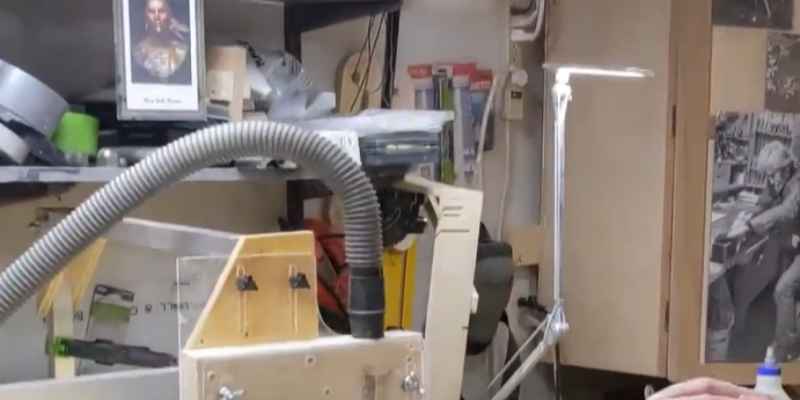If you have a table saw in your workshop, then you know that one of the most annoying things about using it is the amount of dust generated. Not only is this dust unsightly, but it can also be dangerous if it’s not collected correctly. In this blog post, we’ll show you how to improve dust collection on your table saw so that you can keep your workspace clean and safe.
- If you plan to improve the dust collection on your table or saw, you can do a few things to ensure that it is as effective as possible.
- First, you must ensure that the blade guard is in place and that the dust port is open.
- Next, you need to raise the blade to be above the table’s level.
- This will allow for better airflow and more suction from the dust collector.
- Finally, it would be best if you made sure that all the seams in your work area are sealed so that
- there are no gaps for the dust to escape through.
How Do You Make a Dust Collector More Efficient?
You can do a few things if you want to make your dust collector more efficient. First, make sure that the unit is correctly sized for your needs. If it’s too small, it won’t handle the volume of air and dust you’re trying to collect.
Second, ensure that the unit is sealed correctly and that all the ductwork is in good condition. Leaks will allow dust to escape and reduce the system’s overall efficiency. Finally, ensure that the collection bags or drums are regularly emptied so that they don’t become overloaded and cause the system to work less effectively.
Following these tips can help keep your dust collector operating at peak efficiency.

Why Does My Table Saw Throw So Much Dust?
If you’ve ever used a table or saw, you know that it can create a lot of dust. But why does this happen? And is there anything you can do to reduce the dust created?
Table saws work by spinning a blade at high speeds to cut through wood. As the blade spins, it creates friction and generates heat. This heat and friction cause the wood to release microscopic particles into the air, which we call dust.
The amount of dust created by a table saw depends on a few factors, including the type of wood being cut, the speed of the blade, and how dry or wet the wood is. Softer woods like pine or fir create more dust than harder woods like oak or maple. And cutting at higher speeds will generate more dust than cutting at lower rates.
You can do a few things to reduce the dust created by your table saw. First, make sure that your blade is sharp. A dull knife will generate more friction, heat, and dust.
Second, use a slower speed when cutting softer wood. And finally, try to keep your wood as dry as possible before cutting it – moisture will help to bind together those tiny particles, so they don’t end up in the air as much. Overall, there’s no way to eliminate the dust generated by a table saw – it’s just part of the nature of the tool.
But by following these tips, you can minimize it and make your work area a little cleaner and healthier in the process!
Can You Use a Shop Vac for Table Saw Dust Collection?
Yes, you can use a shop vac for table saw dust collection. However, there are some things to keep in mind. First, ensure that the shop vac is powerful enough to handle the dust produced by the table saw.
Second, ensure that the hose on the shop vac is long enough to reach from the outlet on the vacuum to the inlet on the table saw. Finally, empty the shop vac after each use to prevent clogging.
How Do You Seal a Table Saw for Dust Collection?
If you’re looking to improve the dust collection on your table or saw, one option is to seal the cabinet. This can be done by either building a sealed enclosure around the saw or retrofitting an existing wardrobe. Building a sealed enclosure is the more practical option, but it will require some woodworking skills and knowledge.
If you’re not confident in your abilities, then retrofitting an existing cabinet is a viable option. To build a sealed enclosure, you’ll need to measure your table saw’s dimensions. Then, using these measurements, cut out plywood panels or MDF that will fit around the saw.
Once all the panels are cut out, use screws or nails to attach them. Make sure there are no gaps between the boards so that dust can’t escape. Once the enclosure is built, you’ll need to install a dust collection system.
This could be as simple as attaching a shop vac to an exhaust port or installing a more sophisticated system, such as ductwork connected to a central vacuum system. Whichever method you choose, ensure the suction is strong enough to pull all the dust into the collector without leaking air from elsewhere in the enclosure. Several options exist for sealing it up if you’re retrofitting an existing cabinet.
One is to add strips of weatherstripping around all of the doors and openings. This will create a tight seal that will prevent most dust from escaping. Another option is to install flexible PVC tubing over any exposed seams and joints; this tubing can then be connected to your dust collection system so that any escaping dust gets sucked away immediately.
Whichever method you choose for sealing your table saw cabinet, ensure that it’s installed correctly and securely so that no air leaks occur. With proper sealing and ventilation in place, you should notice significantly less airborne dust in your shop – making for a cleaner and healthier work environment!

Credit: staticwoodworks.wordpress.com
Table Saw Top Dust Collector
If you’re looking for a table saw that can handle any woodworking project, you need to consider getting one with a top dust collector. A complete dust collector is a must-have for anyone who wants to keep their workspace clean and free of sawdust. There are many different brands and models of table saws on the market, so it’s essential to research before purchasing one.
Reading online reviews from other woodworkers is an excellent place to start your research. Once you’ve narrowed your options, you can visit your local home improvement store or woodworking shop to get a closer look at the different models. When choosing a table saw with a top dust collector, it’s essential to consider the size of the unit and its airflow capacity.
The larger the unit, the more powerful it will collect sawdust. However, remember that a larger team may also be more expensive. Once you’ve decided on the perfect table, and saw for your needs, be sure to take care of it by regularly cleaning the dust collector and changing the filters when needed.
With proper care, your table saw will provide years of reliable use.
Overarm Dust Collection
An overarm dust collector is a device that is installed over the work area in a woodworking shop. This collector helps clean the air and is free of sawdust and other fine particles. Overarm dust collectors typically have a series of filters that trap the particles before they can be drawn into the unit’s main body.
Many models also include a blower motor that helps to move the air through the system, keeping the filters clean and practical.
Table Saw Dust Collector Adapter
If you use a table or saw, you know that dust is one of the biggest challenges. It can be difficult to keep your work area clean and free of debris, and it can be even more challenging to collect all the dust generated by the saw. A great solution is to use a table saw dust collector adapter.
There are a variety of different adapters available on the market, and they vary in terms of price and features. Some more expensive models offer variable speed control and automatic shut-off features, while others are more basic. Regardless of which model you choose, an adapter will make it much easier to collect the dust generated by your table saw.
To use an adapter, attach it to your saw’s dust port and connect it to your shop vacuum. Once everything is set up, please turn on the saw and vacuum it and let them run for a few minutes. The adapter will funnel the dust into the void, making cleanup a breeze.
Investing in a table saw dust collector adapter is brilliant if you’re looking for an easy way to keep your work area clean and tidy. These adapters make it quick and easy to collect all of the debris generated by your saw, so you can focus on your project instead of worrying about making a mess.
Conclusion
Most woodworkers will eventually need to cut solid wood stock using a table saw. Table saws create a lot of dust, so it’s essential to have a good dust collection. You can do a few things to improve the dust collection on your table saw.
First, ensure your saw is appropriately set up for good dust collection. The blade should be aligned with the miter slots, and the fence should be parallel to the edge. You also want to ensure that your blade guard is in place and that there are no gaps between the guard and the tabletop.
If there are gaps, air can flow through them and carry away more dust. Next, you need to choose a suitable dust collector hose. A clear hose will let you see when it’s getting full of debris and needs to be emptied.
A flexible hose is easier to work with than a rigid one, but the hose must fit snugly over the outlet port on your table saw. Otherwise, air can leak out and reduce the effectiveness of your dust collection system. Finally, keep your work area clean and free of clutter.
Dust will settle on anything in its path, so it’s essential to have a clean workspace where dust can be easily vacuumed up or wiped away before it has a chance to accumulate.



14 thoughts on “How to Improve Dust Collection on Table Saw”